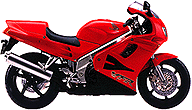

This article was written by Henrik and posted on the VFR List. This post offers clear guidance about adjusting valves on a '94+ VFR. Nice post Henrik and thanks for your permission to use it!
There's nothing really difficult about adjusting the valves on the VFR. It does take time and organization but not much money. Before you start, you will need a set of metric wrenches and socket set, a pad of paper with 16 circles on it to represent each valve (before & after), pen, calipers (inch or metric) and feeler gauges. The standard angled gauges work fine, the best are the step type. These allow you to slide in one (1) size, then the gauge steps up 0.001 so it stops at that point. It will take time to do the valves since once she's torn apart, you need to calculate all the shim sizes, buy the ones you need, replace and re-measure. We (as a group) took the bikes apart, measured, assembled, got shims, then the next weekend took the bikes apart again, replace shims, and assembled. Step-by-step here's how it's done (I stole some of this from C. Salazar and J. Fieliek account posted on the list last year).This description is intended to supplement the manual
If you are organized and meticulous, it's a great way to learn and see how this great bike works. If you are impatient, not very interested in this stuff or the type that doesn't finish what you start, then take it to a shop. BTW, the shop will just adjust to get it within spec, you, on the other hand, can make sure all valves are close to each other to get that little extra performance we all love.
- First step is to remove the tank and all the plastic. Unbolt the radiator bottom, swing it forward, tie it up. Or remove it completely and flush it while it's off.
- Take off the round cover to access the crank shaft (so you can spin the engine with a wrench), take off the valve covers and remove the plugs.
- Hand rotate the crank so the marks are aligned per manual. Then start measuring the clearances. Use different size gauges (stacked or single) until you can just shove it between the cam and the bucket with about as much force as it takes to open a can of beer (you may want to practice the beer part judiciously).
- Write down the actual clearance (total sum of feeler gauges) for each valve, by cylinder, by valve. KEEP IT ORGANIZED, so if it needs changing you know the size shim you will be removing and the new size to put in. Be aware that running outside of tolerance puts you at significant risk for a cooked valve or two, as the valves won't seat fully when the engine is hot, which means that they won't shed heat adequately, which means that eventually you end up with a roasty-toasty valve."
- Now if your clearances are OK, assemble and ride, ride, ride. If your out, then you need to do some more work... continue on.
- The great thing about VFRs is that the overhead cams are gear driven. To remove the cams, simple remove the bolts holding it down and lift the entire cam assembly off. Be careful here, do each cylinder one at a time (so you don't mix cams) and keep the bolts in the same hole they started from. Just take your time, remember the orientation and make sure the cam gear mark and cam drive gear mark are visible, so you can align them up correctly later.
- For the valves that are out to spec, use a magnet to pull the bucket off. The shim (Tums size) usually sticks to the inside of the bucket, but sometimes stays stuck on the valve stem. Measure the shim (they also have the size stamped on them in some code) and record the results. Put the shim back inside the bucket (use a dab of oil as glue) and put the bucket back on the valve. Repeat for each valve out of spec. DON'T do more than one valve or cylinder at a time because if you get them mixed up, your screwed.
- Now, exercise your computational skills and compute each size shim you need to make the out of spec valve be in spec again. You may be able to swap shims between cylinders, but most likely you will have to go to a good shop (or other MC friend) and collect the shims you need.
- Once you have the correct shims, go through and replace each one by one. As you finish each cylinder, spin the crank (starter with no plugs will do) and re-measure the clearance. In real tight cases, you can grind a mil or two off a shim with a grinder but I don't recommend that.
- Assemble the baby and fire her up. I definitely recommend that you do a carb sync after changing any valve shims. The valves do affect the sync and you will get the best results. Last, the amount of wear and out-of-spec depends totally on how the bike was driven, broken in, and time. One bike we worked on had all valves in spec at 13K, 5 years old. Another had 75% out of spec at the first 7K. The next had about 30% out at 25K, with only one or two valves that were seriously out of spec. It takes about 4 hours (at a slow pace) to just take it apart, check, and re-assemble. It takes another 4 hours (slowly) to replace and recheck the shims if out of spec.
Good luck and safe rides
-Henrik '95 VFR750FS, Palo Alto, CA
